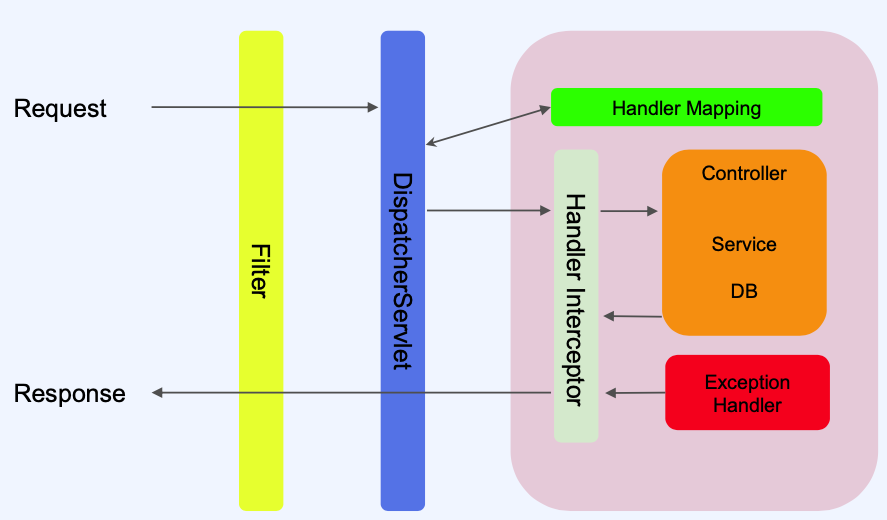Filter를 통한 로그 설정
프로젝트 진행 과정에서 마주한 버그들 기록
Filter를 통한 로그 설정
Filter를 통한 로그 설정하는 방법
- Filter 인터페이스를 구현한 커스텈 필터 클래스를 생성한다.
1
2
3
4
5
6
7
8
9
10
11
12
@Component
public class LoggingFilter implements Filter {
private static final Logger logger = LoggerFactory.getLogger(LoggingFilter.class);
@Override
public void doFilter(ServletRequest request, ServletResponse response, FilterChain chain)
throws IOException, ServletException {
// 로그 수집 로직 구현
// ...
chain.doFilter(request, response);
}
}
- 위와 같이 구현 클래스를 하나 정의한 뒤 아래와 같이
doFilter메서드를 오버라이드하면 된다.
1
2
3
4
5
6
7
8
9
10
11
12
13
14
15
16
17
18
19
20
21
22
23
@Override
public void doFilter(ServletRequest request, ServletResponse response, FilterChain chain)
throws IOException, ServletException {
long startTime = System.currentTimeMillis();
HttpServletRequest httpRequest = (HttpServletRequest) request;
String requestURI = httpRequest.getRequestURI();
String method = httpRequest.getMethod();
// 요청 정보 로그 기록
logger.info("Request: {} {}", method, requestURI);
chain.doFilter(request, response);
long endTime = System.currentTimeMillis();
long timeTaken = endTime - startTime;
HttpServletResponse httpResponse = (HttpServletResponse) response;
int status = httpResponse.getStatus();
// 응답 정보 및 처리 시간 로그 기록
logger.info("Response: {} {} (Time taken: {} ms)", method, requestURI, status, timeTaken);
}
- 하지만 위와 같은 방법으로 요청본문(request body)를 읽으려 했을 경우
IllegalStateException이 발생할 것이다. - 왜냐하면
HttpServlet의getInputStream()또는getReader()를 사용하여 요청 본문(request body)를 읽으면. 스트림이 소비되고 더 이상 읽을 수 없게 된다.- 즉, 요청 본문을 한 번만 읽을 수 있도록 설계되어 있다. 이는 요청 본문이 스트림 형태로 제공되기 때문이다. 스트림을 한 번 읽으면 다시 읽을 수 없고, 재사용할 수 없다.
해결 방법
- 이를 해결하기 위해 요청 본문을 읽은 후 다시 재사용할 수 있도록 래핑(wrapping)하는 방법이다.
1
2
3
4
5
6
7
8
9
10
11
12
13
14
15
16
17
18
19
20
21
22
23
24
25
26
@Override
public void doFilter(ServletRequest request, ServletResponse response, FilterChain chain)
throws IOException, ServletException {
ContentCachingRequestWrapper cachedRequest = new ContentCachingRequestWrapper((HttpServletRequest) request);
// 필터 로직 수행
// ...
// 요청 본문 로그 수집
String requestBody = getRequestBody(cachedRequest);
logger.info("Request Body: {}", requestBody);
// 다음 필터 또는 서블릿으로 요청 전달
chain.doFilter(cachedRequest, response);
// 추가적인 로그 수집 또는 처리
// ...
}
private String getRequestBody(ContentCachingRequestWrapper request) throws IOException {
byte[] contentAsByteArray = request.getContentAsByteArray();
if (contentAsByteArray.length > 0) {
return new String(contentAsByteArray, request.getCharacterEncoding());
}
return "";
}
위와 같이
ContentCachingRequestWrapper클래스를 사용하여 요청 본문을 읽은 뒤에도 캐시된 요청 본문이 유지되도록 할 수 있다.그 외에는 요청 본문이 필요한 경우에만 로그를 수집하거나, 비동기 처리를 사용하여 이러한 문제를 해결 할 수 있다.
- 비동기 서블릿이나 컨트롤러를 사용한 비동기 처리 시에는 요청 본문을 여러 번 읽을 수 있다.
This post is licensed under CC BY 4.0 by the author.
